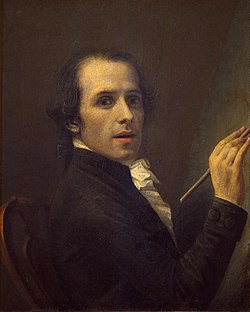History
In December 1815, the House of Commons and the Senate of North Carolina unanimously resolved to commission a full-length statue of Washington. Governor William Miller, with the assistance and recommendation of Thomas Jefferson, determined that Canova should be the sculptor and that Thomas Appleton, American consul in Livorno, Italy, should handle the negotiations. Washington had died in 1799, and Jefferson recommended that Canova use the marble bust of Washington by Giuseppe Ceracchi as a model for the head; Appleton owned a plaster copy. [1]
Canova started work on the statue at his studio in Rome in 1817, completing several sketches and maquettes (also described as modellos or bozzettos). He finished the statue in 1820. [2] Governor Miller had requested a United States Navy vessel to transport it from Italy. Commodore William Bainbridge, commander of USS Columbus, delivered it to Boston on July 22, 1821. The statue ultimately arrived in Raleigh, North Carolina, on December 24 and was installed in the rotunda of the state house as part of an official ceremony, attended by Governor Jesse Franklin and the legislature. Colonel William Polk, an officer in the American Revolutionary War, addressed the audience in the dedication speech, comparing Canova to Michelangelo and praising Washington.
Canova did not see the statue installed in North Carolina: he died in Venice in 1822. In March 1825, the Marquis de Lafayette viewed the statue and was reported to state that "the likeness was so much better than he expected to see." [5]
Following the major fire of May 29, 1831, in Fayetteville, the state decided to protect the wooden roof of the state house with zinc sheets. On June 21, while working to fireproof the building, workers accidentally set the roof on fire while soldering nail heads to the zinc. [6] The resulting destruction of both the state house and Canova's statue was described as an "Awful conflagration!" in The Raleigh Register on June 23. [7]
A plaster replica was sent by the Italian government in 1910 and is on view at the North Carolina Museum of History. A marble copy was sculpted by Romano Vio in 1970, and is displayed in the rotunda of the North Carolina State Capitol, which was built in the same spot as the state house destroyed in 1831. [1]
Legacy
From May 23 through September 23, 2018, the Frick Collection presented an exhibition, Canova's George Washington, that displayed several of the maquettes used to create the work, including a full-size plaster model, on loan from the Museo Canova in Possagno. [2] The exhibition then traveled to the Museo Canova, where it ran from November 10, 2018 until April 22, 2019. [13]
This page is based on this
Wikipedia article Text is available under the
CC BY-SA 4.0 license; additional terms may apply.
Images, videos and audio are available under their respective licenses.






